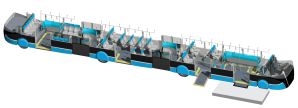In the UK driverless cars has been permitted in several towns from January 1 2015. In my hometown Bergen, we can now see 24m long busses with four sections and herring-in-can capacity of almost 150 commuters. Urban living is stepping up on efficiency and comfort.

Maintaining high capacity on the roads are impossible with all levels of freedom the individual driver has in manual cars. Even on roads I know well I end up in the wrong lane, I brake too hard and cause a full stop in the traffic, and I let my daily temper decide whether someone else gets a spot in my lane. I think I am a much better part of the traffic drooling at commuters from a bus seat, or screaming stop in a car without pedals or steering wheel.
With self driving cars, our role will be to choose where we are going. Algorithms will know where I want to go and where everyone else is going and can pick the optimum route based on large data amounts. By allowing computers to plan the travel route much more information can be consulted than what’s available to me as a driver. Traffic conditions such as road work or accidents, weather and road friction, road capacity, time of the day, politics like pollution reduction, low traffic areas, cost of fuel, and maybe even commercial interests can smoothly ensure safe and efficient urban logistics.
From a technological view I find the developments most pleasing, all the algorithms, hardware, software that is made , coupled with modern design and somewhat unpredictable politics, and the peoples fear of losing freedom and control. Cars driving by themselves, and buses long as trains are able to navigate city corners and pavements.
I think the symbolic and monetary value of our cars today is the biggest hurdle for change. We love to put all our money (and more so) into shiny brands that advertisements and our neighbors recognise as luxurious. We drive faster than all the bad drivers out there and change lanes without flashing the indicator lights. The freedom and social standing of the car is taking a hit with driverless cars. And bigger busses.
I’m not quite sure about the greenness of driving busses in towns, though. For every stop, 24 tons of bus stops and starts again, only to exchange a small percentage of the people onboard with new passengers. Maintaining steady speed on a straight doesn’t require that much energy, but starting and stopping most certainly does. Regenerating energy from braking you say, I’m curious to see the numbers (maybe I’ll do the numbers myself in a later blog post).
I don’t see why we should continue gambling with our lives in the manual traffic, we are only able to take in small amounts of data in our human decision making, and mostly very local data. Computers, algorithms, save vehicles and mass transit systems makes urban living safer and more efficient with the possibilities of smarter planning and utilization of the road networks.
Oops, I’m late, it’s time for me to drive like crazy again. See you out there

